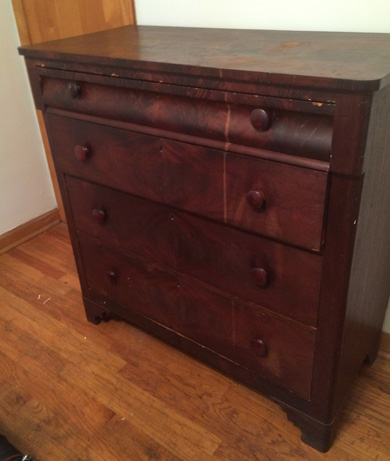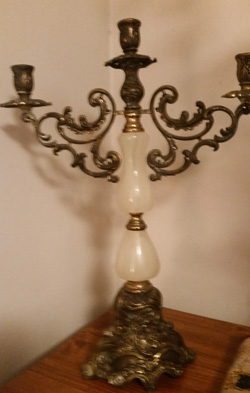 |
|
|||
 |
 |
|||
Copyright © Harry Rinker, LLC 2015 Questions
and Answers
QUESTION: I am an avid reader of your column in the weekly “Farm and Dairy” newspaper. I have a dresser that I was told belonged to my great, great, grandfather when I was little kid almost 70 years ago. It is made of walnut. My mother replaced the period knobs which had wood threads with similar wooden knobs held on with screws. I saw a similar dresser in a museum in Zoar, Ohio. I wonder if my German ancestors brought the dresser from Germany or if it originated in the Pennsylvania German region of Pennsylvania where they first settled. The dresser could use a good cleaning. It has a few stains on top which may be permanent. My kids do not seem interested in keeping the dresser in the family. What can you tell me about its history and value? – DW, Tallmadge, OH, Email Question
ANSWER: Your dresser did not arrive in America with your ancestors. It is American made. The critical question is whether it is hand crafted or factory made. Although the dovetailing in the illustration of the top drawer that accompanied your email appears to be hand rather than machine done, the overall appearance suggests a factory origin. Not all factory work was done by machine. The illustrations also suggest the piece is veneered, not solid wood. The design style of the dresser is a late nineteenth/early twentieth century interpretation of French Restoration, a design style that stresses simple, unadorned furniture lines in reaction to the ornamentation of the Napoleonic furniture. The French Restoration style was extremely popular in the South, where it is mistakenly classified as Second Empire design style, and in the American rural countryside from the 1870s to the 1910s. The varnish has darkened. Removing the old varnish and replacing it with new varnish will improve the piece. The top needs to be refinished. This should be done by someone who has the skill to do it properly. The difficulty is that you will pay more to have it re-varnished and the top refinished than the dresser is worth. The value of the dresser as it stands is between $100.00 and $125.00, a value based on the fact that the design style has little appeal to young people. In restored condition, the value doubles. This assumes the piece is factory made. The above advice changes depending on two “ifs” – if the piece is handmade and if the piece is Ohio in origin. My recommendation is to contact the curator at Zoar and ask her/him to recommend a collector or dealer who is familiar with Ohio made furniture. Contact one and inquire if he/she would be willing to help you determine if the piece has an Ohio origin.
ANSWER: The “MOD DEP” is an abbreviation for modèle depose, a French term meaning registered design. Registered designs used in Europe are similar to an American design patent. Since the item contains no number, the abbreviation may mean the design application has not yet been approved, much like “PAT. PENDING” in the U.S. An eBay search revealed dozens of items ranging from bottles, figurines, and metallic tabletop accessories that are marked “MOD. DEP.” Although some objects were French in origin, most came from Italy. The form, shape, and pattern of the objects suggest a post-World War II manufacturing date sometime in the 1950s and 1960s. Although your candelabrum’s form and design is meant to suggest the late nineteenth century, it definitely is a 1950s or 1960s reproduction (exact copy of a period piece) or a copycat (a stylistic reproduction of a period piece). As such, its “historic” value is minimal. It is highly probably that your candelabrum is the central element from a centerpiece ensemble or a mantel piece garniture set. If true, it is incomplete as it stands. Is it possible the candelabrum was purchased as a standalone unit? The answer is yes. Anything is possible. Although your candelabrum’s historic and collector value is slight, it does have a high decorative value. It is an impossible piece to ignore no matter where it is displayed – dining room table or buffet, hall occasional table, or in a guest bedroom. As a decorator/conversation piece, the candelabrum’s secondary market value is between $45.00 and $55.00, more in a larger urban area where the Baroque style is fashionable. QUESTION: My father recently passed away and left us with 5 full-size Remington statues. Examples include “Coming Thru the Rye” and “Buffalo Horse.” My online research revealed a flooded market, albeit some were cheap copies. My father bought these over 20 years ago. Although not an expert, they appear to be very high quality. The Remington Museum provided me with your contact information. What guidance on value and recommendation on liquidation can you give me? – LW, Atlanta, GA, Email Question ANSWER: I answered a similar question in “Rinker on Collectibles,” Column #1203 almost five years ago. What follows is an update of that answer: Let’s start with basics. The chances of your father’s Frederic Remington sculptures being period pieces are somewhere between slim and none. They are reproductions. Assuming this, the only questions remaining are (1) the quality of the reproductions and (2) their resale value. Reproductions of Remington sculptures have existed for decades. They were a popular “salted” auction item in the late 1980s and early 1990s. Most were made by a reproduction bronze casting manufacturer located near Chattanooga, Tennessee. “Salted” is a term used when an auctioneer adds newly purchased reproductions (exact copies), copycats (stylistic reproductions), and fakes (items deliberately meant to deceive) to an estate auction hoping buyers will assume that the new items are part of the estate and, hence, older than they really are. It may be hard to accept that your statues are reproductions and not an exception to the rule. If a statue does not have a period foundry market, it is a later copy. The bases of period Remington sculptures are bronze. A marble base indicates a copy. Remington used a single number to identify the pieces he had made. If there are several numbers, for example “21/200,” the piece is a later copy. In the 1980s and 1990s, period Remington bronzes were selling for over $100,000.00. If your father paid this or more for each piece, you need to have the pieces authenticated. A list of dealers who are capable of appraising period Remington bronzes is available at http://fredericremington.org/authentication-and-appraisal-c31.php. In 2010, several bronze manufacturers offered reproduction copies of Remington’s “Coming Thru the Rye” as well as several dozens of his other sculptures. Bronze Works sold a 29in x 28in version for $1,899.00 or a “museum quality” version for $3,299.00. F & R Bronze listed a 29in x 30in version for $2,737.00, but discounted it at $2.295.00. Bronze Direct offers a 30in x 30in version for $2,500.00. The issue is not what these reproductions sell for new, but what they achieve in the secondary market. When reproduction Remington statues appear on the secondary market, anything over a dime on the initial purchase dollar makes the seller a winner. Their only value is decorative. They are not, repeat NOT, works of art, no matter what the certificate of authenticity that accompanies many of them states. The good news is that these statues do sell at 10 to 15 cents on the dollar on eBay. Whatever money is achieved when they are sold is more money than the owner has at present. My advice is to send them through a reputable auctioneer, such as Red Baron Antiques in Atlanta, or list them on eBay and let them ride. QUESTION: I have a 1953 tabletop Motorola television set. It has a Bakelite case. It does not work. Does it have any value? – K, Reading, PA ANSWER: How many different models did Motorola make in 1953? Much to my surprise, the answer is more than 25. Models 21T3 and 21T4 were 21” tabletop models with mahogany color Bakelite cases. Model Y17T15 was a 17” tabletop model with an ebony Bakelite case. Hence, without knowing the model number, it is hard to provide a detailed answer to your question. What I can confirm is that since your set is not working, its primary value at this point is for parts. A person specializing in repairing old televisions will pay between $10.00 and $15.00. Do not be surprised if he/she offers to take it off your hands for nothing, the assumption being he/she is doing you a favor. The person is. Even in working order, 1950s black and white television sets usually sell in the $30.00 to $50.00 range. Sets with futuristic Modernist case designs are an exception.Harry L. Rinker welcomes questions from readers about
collectibles, those mass-produced items from the twentieth and twenty-first centuries.
Selected letters will be answered in this column.
Harry cannot provide personal answers.
Photos and other material submitted cannot be
returned.
Send your questions to: Rinker on Collectibles, 5955 Mill
Point Court SE, Kentwood, MI 49512.
You also can e-mail your questions to
harrylrinker@aol.com.
Only e-mails containing a full name and mailing address
will be considered.
You can listen
and participate in
WHATCHA GOT?, Harry’s
antiques and collectibles radio call-in show, on Sunday mornings between 8:00 AM
and 10:00 AM Eastern Time.
If you
cannot find it on a station in your area,
WHATCHA GOT?
streams live on the Internet at www.gcnlive.com.
SELL, KEEP OR TOSS?: HOW TO DOWNSIZE A HOME,
SETTLE AN ESTATE, AND APPRAISE PERSONAL PROPERTY
(House of Collectibles, an imprint of Random House Information Group, $17.99),
Harry’s latest book, is available at your favorite bookstore and via
www.harryrinker.com.
|
||||

 QUESTION: Years ago, my friend presented me with a candelabrum. The two arms have an elaborate filigree design. The center standard is topped by a candle holder and contains two bulbous cloudy glass units. The cast mound-shaped base has a relief foliage design that is Baroque in feel. The bottom is marked “MOD. DEP. MADE IN ITALY.” Is it worth selling? – PB, Fordyce, AK, Email Question
QUESTION: Years ago, my friend presented me with a candelabrum. The two arms have an elaborate filigree design. The center standard is topped by a candle holder and contains two bulbous cloudy glass units. The cast mound-shaped base has a relief foliage design that is Baroque in feel. The bottom is marked “MOD. DEP. MADE IN ITALY.” Is it worth selling? – PB, Fordyce, AK, Email Question